Narrowly missing out on promotion to Ligue 1 in the 2020-21 season, before losing in the playoff final, Toulouse had extra incentive to achieve their goal this season. The manner of that two-legged defeat to Nantes, the last decided by the away goals rule, fuelled their desire even more.
The South of France side were relegated in season 2019-20 when the league was cut short due to the coronavirus pandemic. However, with ten games to go and being 14 points from safety, relegation appeared inevitable. Damien Comolli, who had previously worked in the recruitment department of EPL clubs Arsenal, Tottenham Hotspur, and Liverpool, came into the club as president that summer.
Comolli used statistics to determine that the best-attacking team in Ligue 2 had the best chance of automatic promotion. A team’s defensive performance was deemed as less important, with few teams holding the best defensive record gaining promotion. Going against the conventional wisdom of “defence wins championships”. These statistics were used to guide the club’s recruitment policy and the team’s playing philosophy.
Head Coach Philippe Montanier, appointed in June 2021, has implemented Comolli‘s attacking philosophy to great effect. The former Real Sociedad and Nottingham Forest boss has his side playing free-flowing, expansive football.
This analysis will be presented in the form of a scout report. The focus will be on Toulouse’s build-up play and how they create goalscoring opportunities through their use of inverted wingers. In this tactical analysis, we analyse the key tactics behind Toulouse’s promotion success in the 2021-22 campaign.
Statistical Analysis
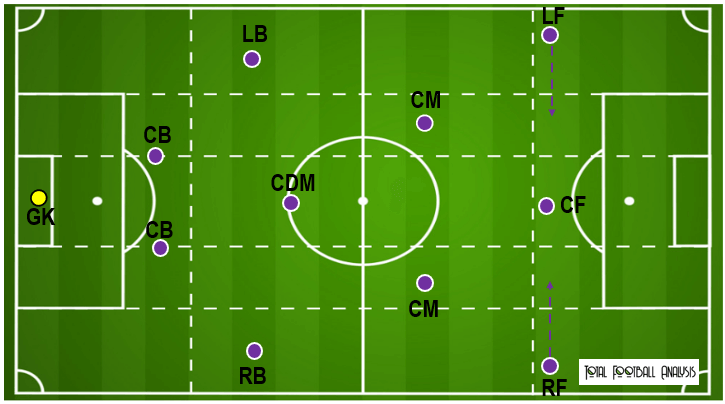
As the above tactical diagram shows, Toulouse’s preferred formation in the 2021/22 season was a 4-3-3. However, as will be covered in the next section, they often created a 4-2-4 or even a front five in the build-up phase. The front three, as indicated in the diagram, often played inverted with the wingers occupying the half-spaces.
Montanier’s attacking philosophy is evident in his side’s 2021/22 league statistics. Toulouse scored by far the most goals in Ligue 2 with 82. The next highest goals tally was Auxerre’s, who finished the season in third-placed, with 61. Ajaccio, who claimed the second automatic promotion spot, scored less than half Toulouse’s total with 39.
Toulouse took more shots than any other team with an average of 12.53 per 90 minutes. The quality of their shots was also impressive. They finished third for shot accuracy with 39.8% of their shots being on target. These two statistics combine to contribute to their average xG of 1.78 per match. Their xG was almost a goal more per match than their direct opponent’s average of 0.8xG
Toulouse showed great diversity in how they scored their goals. 13 were hit from outside the penalty area, the most in the league. They also scored the most headers with 19. 11 of these headers came from the 14 corners they scored from – another league-high. Ligue 2’s top scorer, Number ‘9’ Rhys Healey, claimed six of these headers. The former MK Dons and Newport County striker has netted 37 times in his 73 appearances for Toulouse. The Englishman, who also qualifies to play for Wales, is rumoured to have just turned down an extension to his contract that is currently due to expire in June 2023.
Les Violets had the highest average possession in the league with 59.2%. Although they kept the ball well, it was not possession for its own sake. As the statistics above show, they created lots of chances with their possession. As will be analysed in the next section, they were also willing to play long balls during the build-up phase. They averaged 46.02 long passes per 90 minutes, the fifth-most in the league, and were fourth in the league for long pass accuracy with 57.6%.
Build-up play
During the build-up phase, the opposition often drops off into a mid-block. Toulouse react by having one or two of their midfield three dropping close to, or into, their backline. The other midfielder or midfielders push up to join the front three. This leaves the centre of the pitch empty with either a front four or a front five playing up against the opposition’s defence.
Having so many players high means that all the opposing defenders are occupied. This allows the forwards to make movements that pull their marker out of position and create separation between the defenders. It also gives Toulouse the option to play into their forward’s feet or hit long balls in behind.
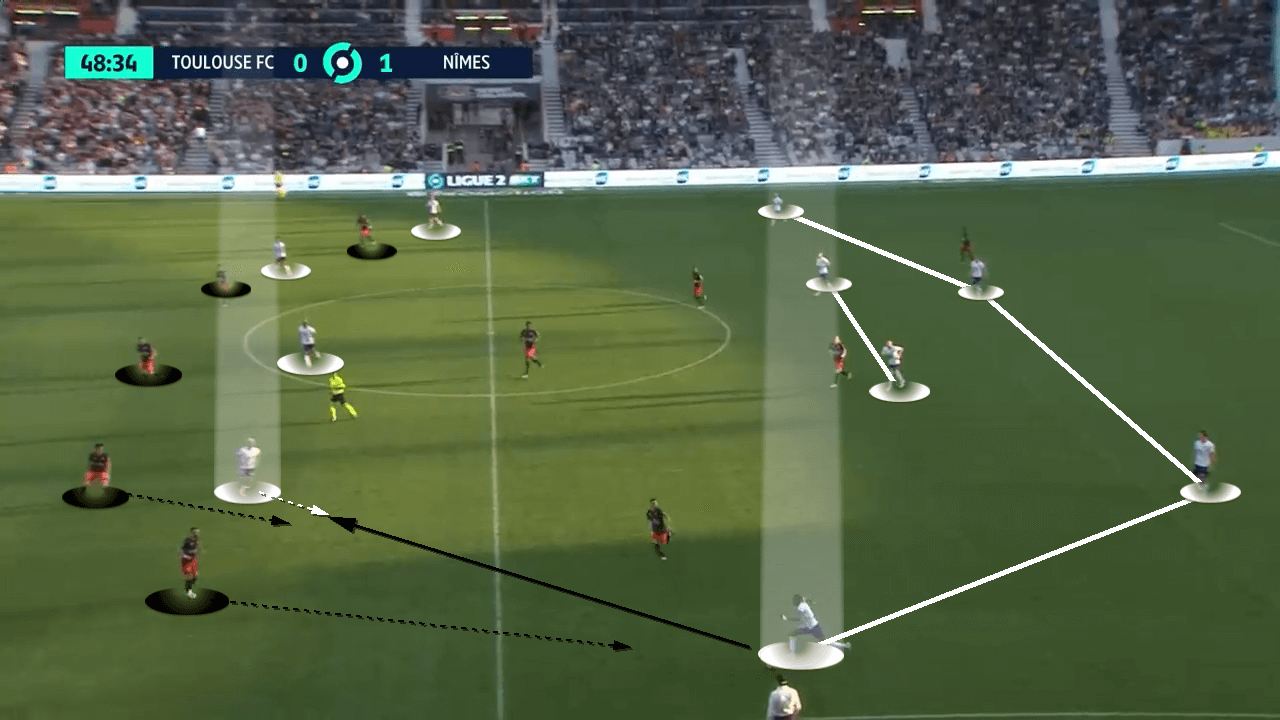
As shown in the above image, Toulouse are building up in a 4-2-4 against Nîmes’ back five. The three forwards are playing up against Nîmes’s three centre-backs. The wingers taking up these inverted positions is an important aspect of how Montanier has his team attack. This will be covered in more detail in the next section.
Nîmes mid-block aimed to keep their central midfielders narrow and encourage Toulouse to play into the wide areas. When the ball was passed wide, into Toulouse’s full-backs, it was Nîmes’ wing-backs that pressed the ball. This left Nîmes’s four on four at the back.
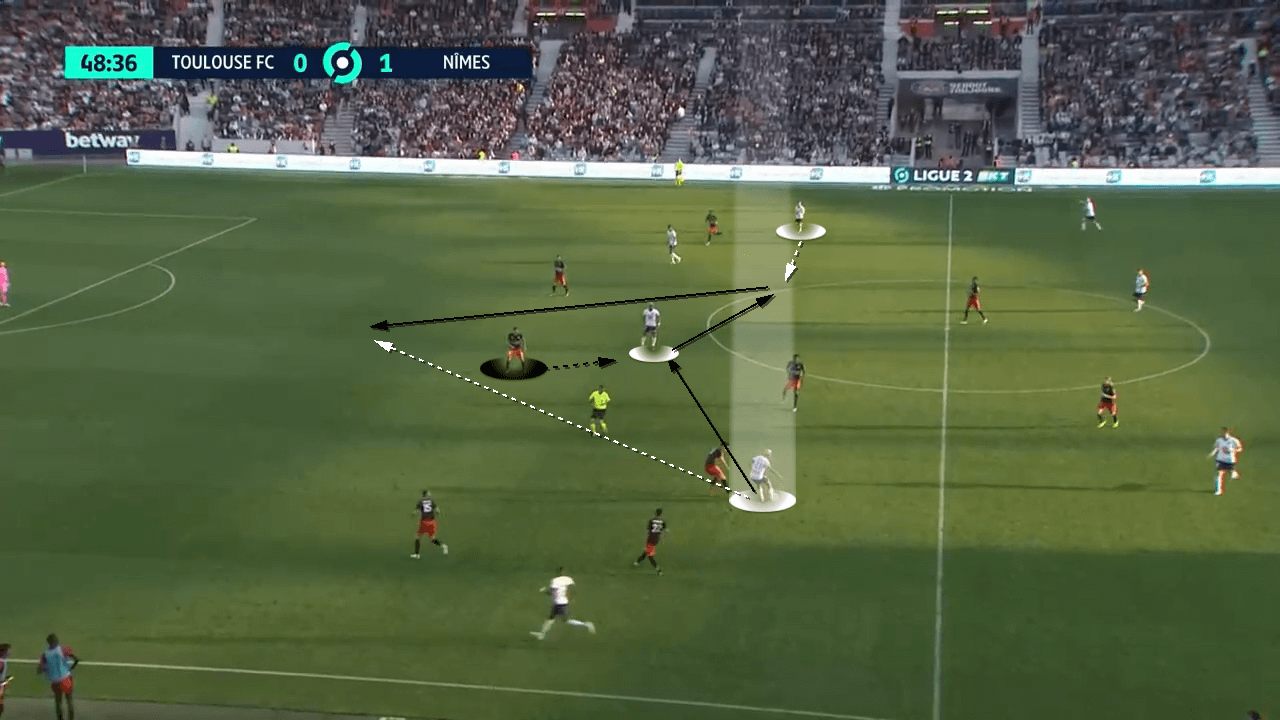
As the above image shows, by creating one-on-ones across the backline, the forwards now control where the space is. The left-winger moving towards the ball to receive it brings the right centre-back with him. The left-forward then passes to his centre-forward who is playing in front of the central centre-back. The centre-back jumps to the ball creating a huge gap in Nîmes’s backline.
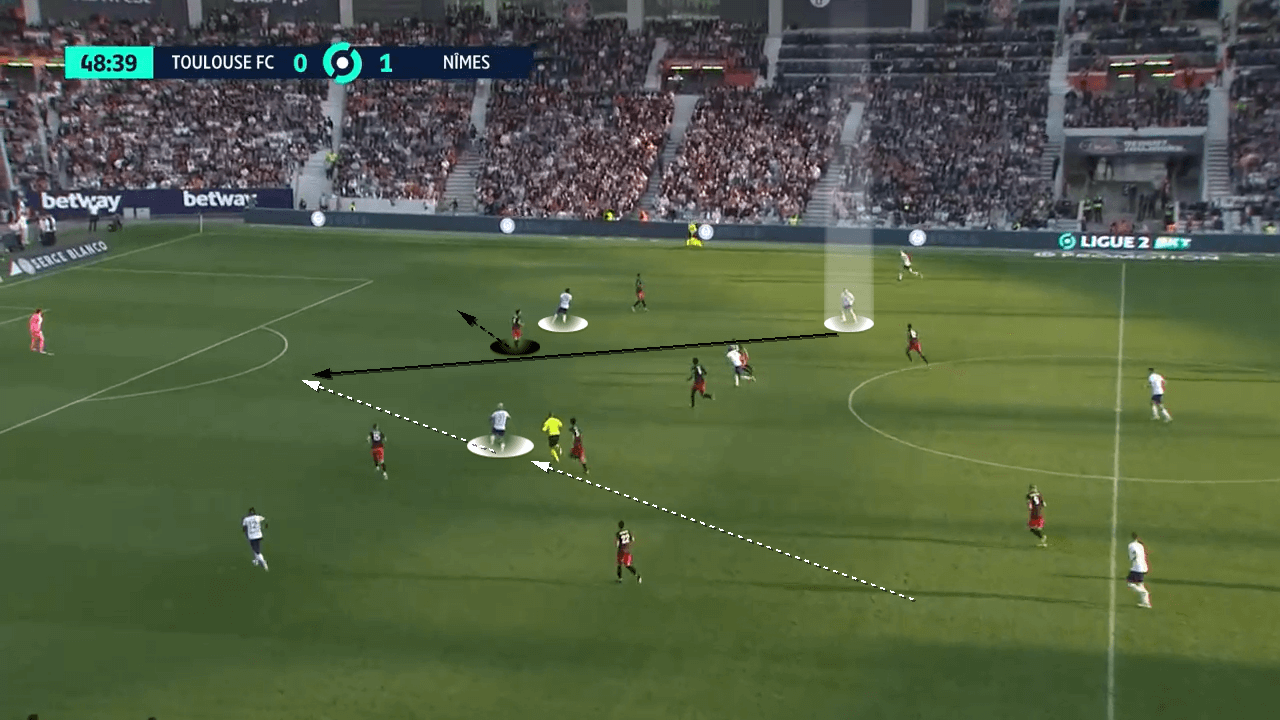
The centre-forward then passed to his central midfielder (highlighted), who had moved inside from the wide area. The left centre-back, wary of the inverted right-winger, dropped into the space behind the forward to cover him. This created an even bigger hole for the left winger to run through.
Even with the right wing-back desperately trying to sprint across and cover for his centre-backs, Toulouse’s midfielder comfortably plays a through ball to his left-winger. The left-winger then laid the ball to his centre-forward who finished to score the equalising goal.
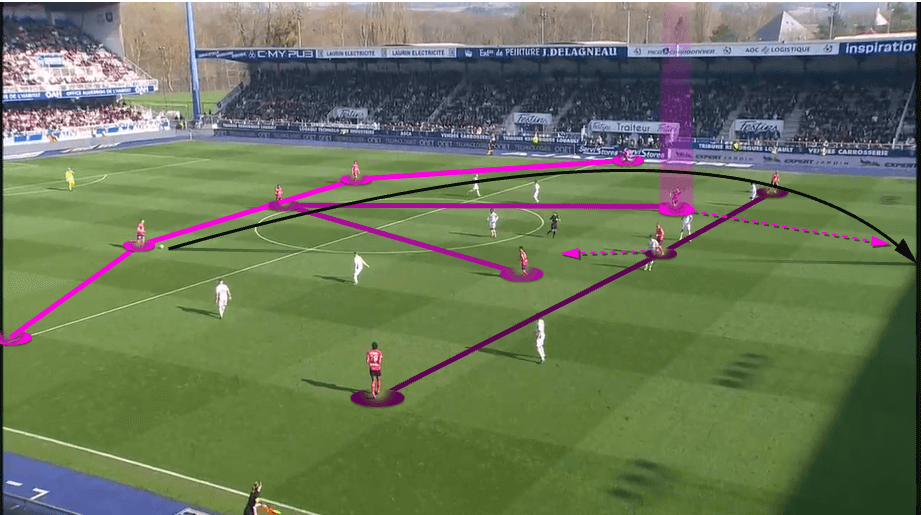
On this occasion, Toulouse are building in almost a 5-0-5 formation against a 4-4-1 (Auxerre were down to 10 men). The DMC has dropped between the two centre-backs with the two central midfielders playing behind Auxerre’s midfield. This effectively created a five-on-four on Auxerre’s backline
Although they are a possession-based team, Montanier’s men will play long when it is plausible to do so. With little room between the lines and a lot of space to hit in behind, Toulouse’s centre-back elected to play a long diagonal.
Just before the long ball was hit, the ball-near midfielder and the centre-forward, Healey, showed for the ball into their feet. This drew the ball-near centre-back towards the ball forcing the ball-far centre-back to shift across slightly.
The left-winger, on this occasion, stayed wide to stretch the back four and is occupying the Auxerre right-back. The right-back covering the wide area, combined with Healey’s movement distracting the ball-far centre-back, created enough room for the ball-far central-midfielder to run through.
The midfielder runs through, on the blindside of the centre-backs, onto a perfectly flighted diagonal ball played over the ball-far centre-backs head. The central midfielder received the ball in the box and slotted it past the onrushing goalkeeper.
Inverted wingers
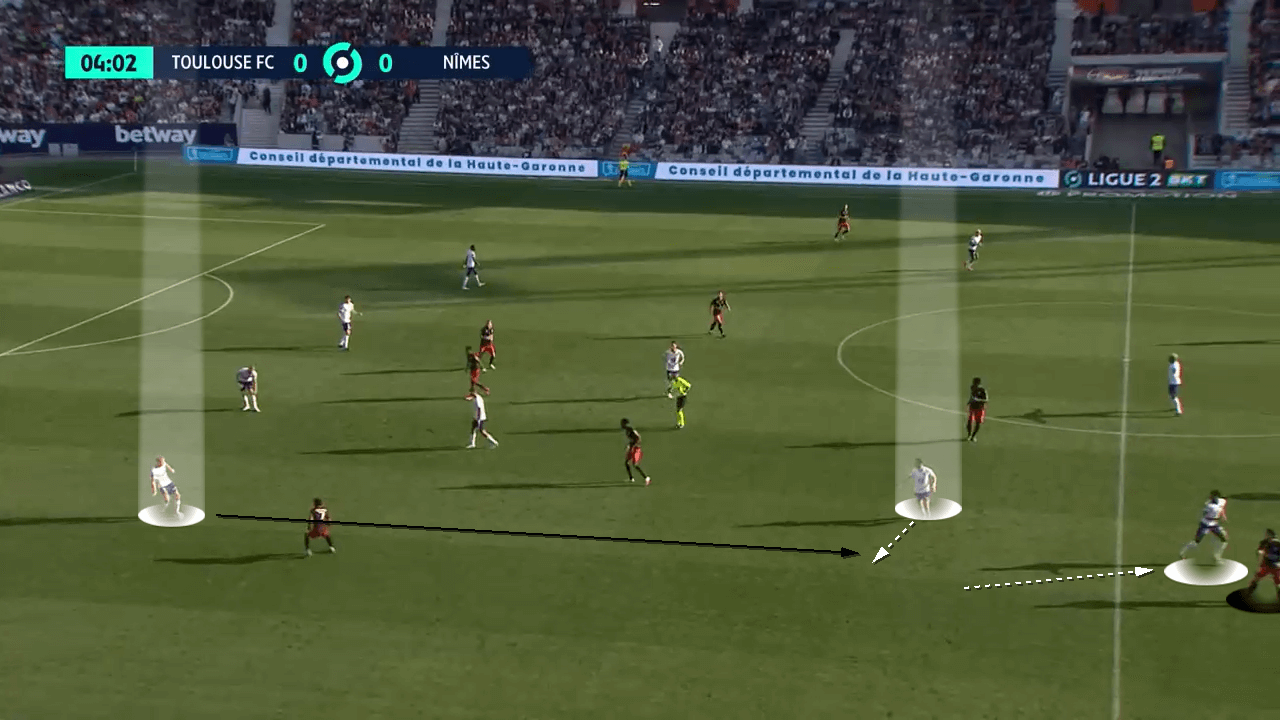
As touched on in the previous section, Montanier often has his wingers play inverted, in the half-spaces, instead of holding their width in the channels. Usually, this means they are either occupying the side centre-backs against a back three/five or the fullbacks, who are forced to pay narrow, against a back four.
The above scenario shows the moments after Toulouse have regained possession against Nîmes. Instead of pulling out wide, the inverted winger plays up against the side centre back. This pins the defender preventing him from pressing the area ahead of him.
Toulouse’s central-midfielder moves into the space that is being protected by his winger. Nîmes’s DMC is reluctant to get pulled into that position, instead of wanting to defend the central area, which allows the midfielder to receive the ball in a pocket of space.
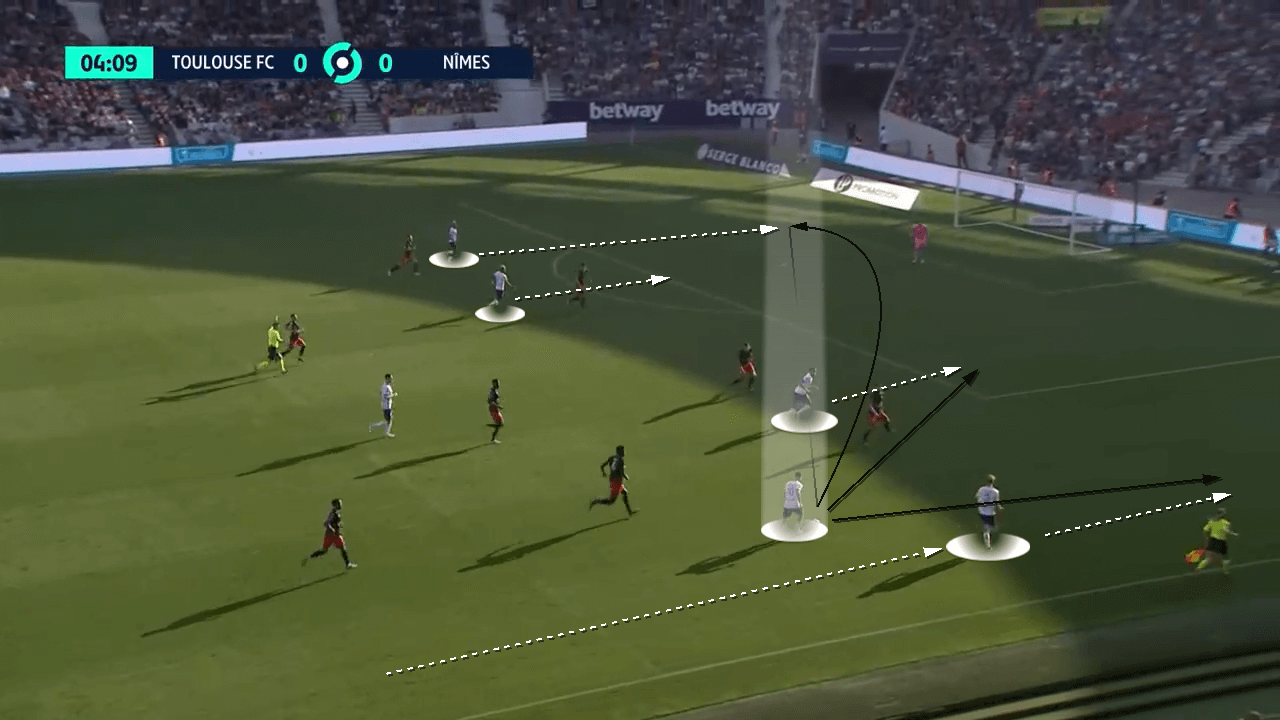
As touched on in the previous section, Montanier often has his wingers play inverted, in the half-spaces, instead of holding their width in the channels. Usually, this means they are either occupying the side centre-backs against a back three/five, or the fullbacks (who are forced to play narrow) against a back four.
The above scenario shows the moments after Toulouse’s midfielder, who received in space, was then allowed to turn and drive with the ball into the opposition’s half. With the ball now in the final third, the midfielder has multiple options to create a goalscoring opportunity.
Whilst he was progressing with the ball at his feet, his right-back overlapped him. The right-wingers positioning, now between the central centre-back and left centre-back, prevented the left centre-back from closing the space between him and Toulouse’s overlapping right-back. The right-back could have been played in to deliver an unopposed cross.
The right-wingers positioning, whilst providing space for his full-back, also positions him well to receive a slide through ball.
As the play developed, the inverted positioning of winger on the opposite side of the pitch (highlighted) also became important. The left-winger coming inside the pitch has created a two-on-two at the back area and means the ball can be crossed into the box early. The midfielder elected to deliver an early cross which his winger received and cut the ball back across goal.
The positioning of the forwards in the build-up meant that all three were affecting the play and in a position to attack the goal.
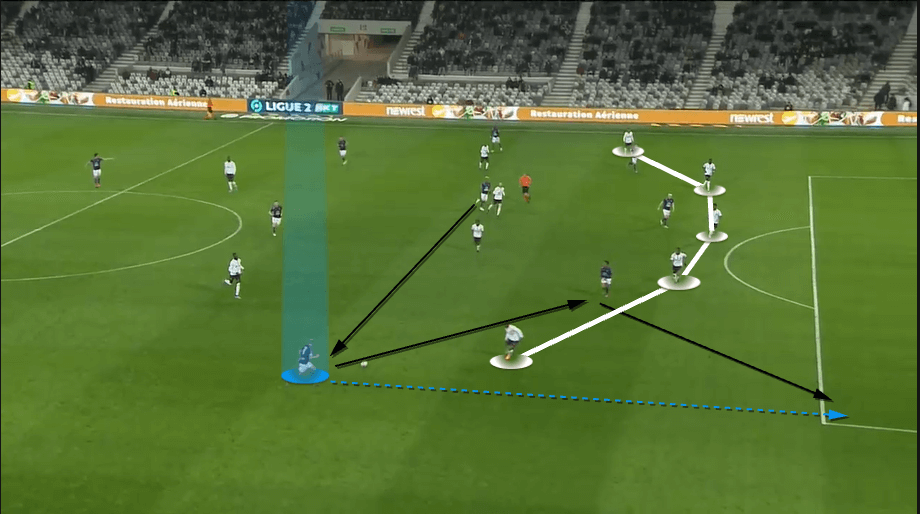
The above image shows the positioning of Toulouse’s front three on a switch of play. Both the right-winger and right-back are in the right half-space. The right-back receiving in this position allows him to drive directly at the left wing-back, pinning the defender in position.
As the right-back takes his first touch forward, towards the wing-back, his left-winger runs across the side centre-back to receive a bounce pass. This movement, in front of the centre-back, prevents the defender from intercepting the initial pass and screens him from blocking the second one.
When the right-back receives the ball back, he aims a low cross played first time into the six-yard box. With Healey ready to pounce, the ball is turned into his own net by the centre-back.
Conclusion
Comolli’s vision to be promoted playing attacking, front-foot football has been realised, although it should be noted that whilst this has held true for Toulouse, Ajaccio were promoted, in second place, by scoring 43 goals less.
Montanier’s implementation of the club’s philosophy, coupled with his adaptability and innovation, make Toulouse an exciting and effective team to watch. The Frenchman’s willingness to play long and play with inverted full-backs and wingers at the same time, goes against conventional wisdom on positional play that most possession-based teams adopt.
Toulouse had the sixth youngest team in ligue 2 last season with an average age of 25.4. This would have placed them as the 5th youngest team in Ligue 1. If they can keep those players together, especially Healey, they could have an exciting few season ahead of them.





Comments